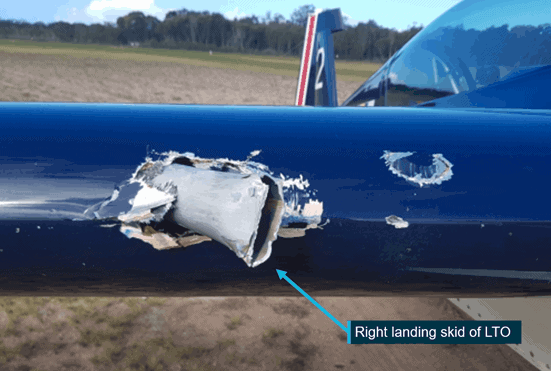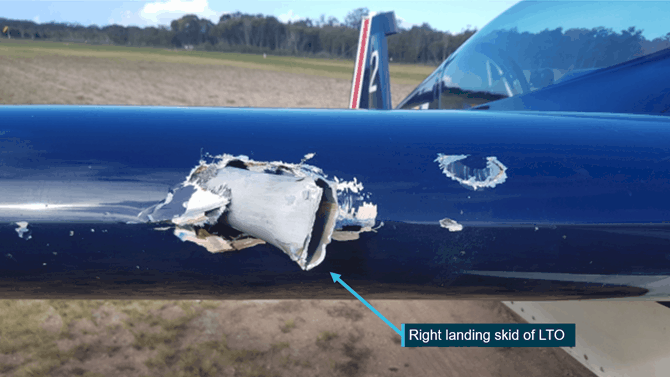Queensland Extra Aerobatic Collision Underscores Importance of Pilot Awareness of Circuit Procedures

ATSB investigation: A high-performance Extra aerobatic aircraft’s collision with a helicopter on a Queensland runway highlights the importance of pilots’ awareness of circuit procedures for differing kinds of aircraft.
On September 18, 2020, a two-seat Extra aerobatic EA-300 aircraft with two experienced pilots onboard was conducting circuits at 1,000 ft (above airport elevation) at Caloundra Airport, a non-towered airport where aircraft self-separate from each other using radio calls on the Common Traffic Advisory Frequency (CTAF). The pilot-in-command occupied the Extra’s front seat, and was conducting a check flight of the rear-seat pilot.
A two-seat Guimbal Cabri G2 helicopter, with a solo student pilot on board conducting a navigation exercise flight from Redcliffe, joined the circuit ahead of the Extra aerobatic and was conducting a stop-and-go on the active runway.
The Extra aerobatic landed on the runway behind the helicopter.
During the landing roll, it collided with the rear of the hovering helicopter, resulting in substantial damage to both aircraft. The helicopter sustained multiple propeller strikes underneath the cabin and separation of its right landing skid. The Extra’s wooden propeller was destroyed by the impact with the helicopter’s fuselage and landing skid, which punctured the Extra’s right wing fuel tank. Fortunately, there were no injuries.
“The ATSB found the pilots of the Extra did not expect the helicopter to join the 1,000 ft. circuit pattern and did not assimilate the helicopter pilot’s radio calls into their mental models of the current operations at the airport. As a result, they were not aware that the helicopter was ahead of them in the circuit,” said ATSB Director Transport Safety Stuart Macleod.
The ATSB also identified that, on the final leg of the circuit, the pilots of the Extra were focused on a third aircraft in the circuit, which was ahead of the helicopter, and which they had been in radio communications with.
“While the pilots visually scanned the runway prior to landing, they were not aware of the helicopter’s presence, and they perceived a different aircraft to be the next ahead of them in the circuit, which resulted in them not sighting the helicopter and continuing the approach to the runway,” Mr. Macleod said.
Further, the tail-dragger Extra’s nose-high altitude during landing obscured the hovering helicopter until immediately before the collision.
During interviews with the ATSB, the rear-seat pilot reported an expectation that helicopters would generally remain clear of circuit traffic — and that they have never known helicopters to hover over runways — while the front-seat pilot noted that helicopters regularly approach Caloundra but most remain clear of the circuit.
Mr. Macleod said the accident highlights the importance for pilots of having an awareness of the circuit procedures for different types of aircraft at non-towered airports, including helicopters.
“A helicopter performing a stop-and-go will usually require significantly more time to clear the runway, compared to an aeroplane performing a touch-and-go,” he said.
“Around CTAF and uncontrolled airports there is the possibility of aeroplanes and helicopters conducting movements that might not be considered commonplace. This investigation highlights that multiple options are available to helicopters at non-towered airports, including the active 1,000 ft, circuit pattern.”
Although not a factor in this occurrence, due to the speed of the Extra it could be classified as a high-performance aircraft, as it is capable of a downwind speed of greater than 150 kt, allowing it to fly a circuit at 1,500 ft.
“All pilots are reminded that the 1,500 ft. circuit height is not just limited to regular passenger transport and turbine aircraft,” Mr. Macleod said.
Safety around non-towered airports is one of the ATSB’s eight ‘most wanted’ safety priorities, as part of the SafetyWatch initiative.
“The alerting provided by radio broadcasts at non-towered airports such as Caloundra greatly assists the process of sighting traffic that might be a collision risk,” Mr. Macleod noted.
“This accident reinforces that, even for experienced pilots, visual identification of unknown traffic is difficult.”

Key points from the investigation of the high-performance Extra aerobatic aircraft
- Pilots of a high-performance Extra aerobatic aircraft did not expect a helicopter to join the circuit ahead of them and did not assimilate the helicopter pilot’s radio calls;
- During the landing roll, the Extra collided with the rear of the hovering helicopter, resulting in substantial damage to both aircraft;
- Multiple options are available to helicopter traffic at non-towered airports including the active 1,000 ft circuit pattern;
- For circuit operations, some single piston aircraft could be classified in the high performance aircraft category.
Source: ATSB, Investigation AO-2020-051, “Collision on runway between Extra EA-300 aeroplane, VH EXR and Guimbal Cabri G2 helicopter, VH-LTO, Caloundra Airport, Queensland, on 18 September 2020.”
Circumstances can crop up anywhere at any time if proper and safe sequence and procedures are not planned and followed. We encourage you to learn and use the TapRooT® System to find and fix problems.
TapRooT® has a team of investigators and instructors with years of extensive training ready to offer assistance worldwide. We also offer ongoing support to our clients through free newsletters and root cause tip videos, the root cause analysis blog, and our annual Global TapRooT® Summit.
Register today for a free webinar with Alex Paradies:
| Nov 18, 2021 | 02:00 PM | EST (NYC) | 60 Min | Situational Awareness: Understanding Human Performance Difficulties Webinar (FREE) | ONLINE |
Then, register for Alex’s Stopping Human Error course:
| May 02, 2022 | 09:00 AM | EST (NYC) | 2 Days | Stopping Human Error | Knoxville, TN |
Check out which TapRooT® courses fit your needs. We offer a basic 2-day course and an advanced 5-day course. Contact us or call 865.539.2139 about having a course at your site or for further root cause analysis opportunities. We’re here to find solutions for you.
Contact us to discuss training your employees on-site. You may also call us at 865.539.2139 to speak to an instructor, schedule an executive briefing, or book on-site training for your team.



